Related Research Articles

A mosaic is a pattern or image made of small regular or irregular pieces of colored stone, glass or ceramic, held in place by plaster/mortar, and covering a surface. Mosaics are often used as floor and wall decoration, and were particularly popular in the Ancient Roman world.

Daphni or Dafni is an eleventh-century Byzantine monastery eleven kilometers northwest of central Athens in the suburb of Chaidari, south of Athinon Avenue (GR-8A). It is situated near the forest of the same name, on the Sacred Way that led to Eleusis. The forest covers about 18 km2 (7 sq mi), and surrounds a laurel grove. "Daphni" is the modern Greek name that means "laurel grove", derived from Daphneion (Lauretum).
Tunbridge ware is a form of decoratively inlaid woodwork, typically in the form of boxes, that is characteristic of Tonbridge and the spa town of Royal Tunbridge Wells in Kent in the 18th and 19th centuries. The decoration typically consists of a mosaic of many very small pieces of different coloured woods that form a pictorial vignette. Shaped rods and slivers of wood were first carefully glued together, then cut into many thin slices of identical pictorial veneer with a fine saw. Elaborately striped and feathered bandings for framing were pre-formed in a similar fashion.
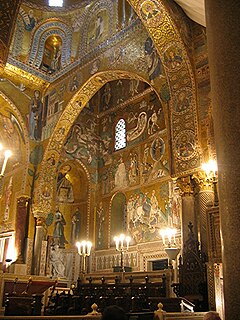
A tessera is an individual tile, usually formed in the shape of a square, used in creating a mosaic. It is also known as an abaciscus or abaculus.

A slot antenna consists of a metal surface, usually a flat plate, with one or more holes or slots cut out. When the plate is driven as an antenna by an applied radio frequency current, the slot radiates electromagnetic waves in a way similar to a dipole antenna. The shape and size of the slot, as well as the driving frequency, determine the radiation pattern. Slot antennas are usually used at UHF and microwave frequencies at which wavelengths are small enough that the plate and slot are conveniently small. At these frequencies, the radio waves are often conducted by a waveguide, and the antenna consists of slots in the waveguide; this is called a slotted waveguide antenna. Multiple slots act as a directive array antenna and can emit a narrow fan-shaped beam of microwaves. They are used in standard laboratory microwave sources used for research, UHF television transmitting antennas, antennas on missiles and aircraft, sector antennas for cellular base stations, and particularly marine radar antennas. A slot antenna's main advantages are its size, design simplicity, and convenient adaptation to mass production using either waveguide or PC board technology.

Cosmatesque, or Cosmati, is a style of geometric decorative inlay stonework typical of the architecture of Medieval Italy, and especially of Rome and its surroundings. It was used most extensively for the decoration of church floors, but was also used to decorate church walls, pulpits, and bishop's thrones. The name derives from the Cosmati, the leading family workshop of craftsmen in Rome who created such geometrical marble decorations.

The Cathedral of Monreale is a church in Monreale, Metropolitan City of Palermo, Sicily, southern Italy. One of the greatest existent examples of Norman architecture, it was begun in 1174 by William II of Sicily. In 1182 the church, dedicated to the Nativity of the Virgin Mary, was, by a bull of Pope Lucius III, elevated to the rank of a metropolitan cathedral. Since 2015 it is part of the Arab-Norman Palermo and the Cathedral Churches of Cefalù and Monreale UNESCO World Heritage site.
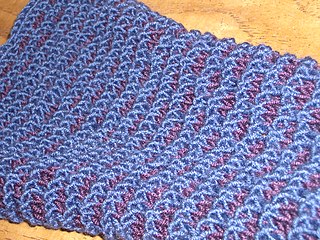
Slip-stitch knitting is a family of knitting techniques that use slip stitches to make multiple fabrics simultaneously, to make extra-long stitches, and/or to carry over colors from an earlier row.

Opus vermiculatum is a method of laying mosaic tesserae to emphasise an outline around a subject. This can be of one or more rows and may also provide background contrast, e.g. as a shadow, sometimes with opus tessellatum. The outline created is often light and offset by a dark background for greater contrast. The name opus vermiculatum literally means "worm-like work", and has been described as one of the most demanding and elaborate forms of mosaic work. Usually opus vermiculatum is meant to put emphasis on the main design and foreground details of a work, using a smooth and flowing halo-effect. Sometimes it was used only around the head of a figure. The tesserae used were often square but can be variously shaped.

Hellenistic art is the art of the Hellenistic period generally taken to begin with the death of Alexander the Great in 323 BC and end with the conquest of the Greek world by the Romans, a process well underway by 146 BCE, when the Greek mainland was taken, and essentially ending in 30 BCE with the conquest of Ptolemaic Egypt following the Battle of Actium. A number of the best-known works of Greek sculpture belong to this period, including Laocoön and His Sons, Venus de Milo, and the Winged Victory of Samothrace. It follows the period of Classical Greek art, while the succeeding Greco-Roman art was very largely a continuation of Hellenistic trends.

Opus tessellatum is the Latin name for the normal technique of Greek and Roman mosaic, made from tesserae that are larger than about 4 mm. It is distinguished from the finer opus vermiculatum which used tiny tesserae, typically cubes of 4 millimetres or less, and was produced in workshops in relatively small panels which were transported to the site glued to some temporary support. Opus tessellatum was used for larger areas and laid down at the final site. The two techniques were often combined, with small panels of opus vermiculatum called emblemata at the centre of a larger design in opus tessellatum. The tiny tesserae of opus vermiculatum allowed very fine detail, and an approach to the illusionism of painting. There was a distinct native Italian style of opus tessellatum using only black on a white background, which was no doubt cheaper than fully coloured work.
The House of the Cascade is a Roman-era building located in Utica, Tunisia. It is typical of most of the Roman houses excavated to date in North Africa in that it looks inwards to a central courtyard around which the majority of the rooms are arranged. Two smaller courtyard gardens in the western part of the house provided additional light and air.

The Domus Romana, stylized as the Domvs Romana, is a ruined Roman-era house located on the boundary between Mdina and Rabat, Malta. It was built in the 1st century BC as an aristocratic town house (domus) within the Roman city of Melite. In the 11th century, a Muslim cemetery was established on the remains of the domus.

A Roman mosaic is a mosaic made during the Roman period, throughout the Roman Republic and later Empire. Mosaics were used in a variety of private and public buildings, on both floors and walls, though they competed with cheaper frescos for the latter. They were highly influenced by earlier and contemporary Hellenistic Greek mosaics, and often included famous figures from history and mythology, such as Alexander the Great in the Alexander Mosaic.

The Museum of Mosaics is a museum in the town of Devnya in Varna Province, northeastern Bulgaria. The museum, built on top of a large ruined Roman villa from Late Antiquity, exhibits mosaics from the Roman and early Byzantine city of Marcianopolis, as well as other archaeological artifacts.
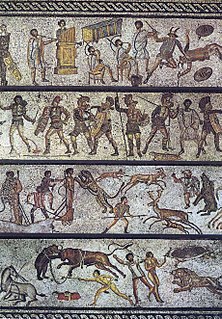
The Zliten mosaic is a Roman floor mosaic from about the 2nd century AD, found in the town of Zliten in Libya, on the east coast of Leptis Magna. The mosaic was discovered by the Italian archaeologist Salvatore Aurigemma in 1913 and is now on display at The Archaeological Museum of Tripoli. It depicts gladiatorial contests, animal hunts, and scenes from everyday life.
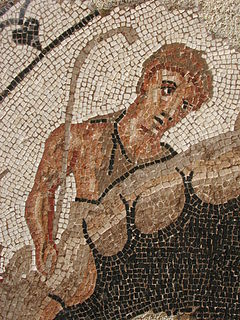
The Mosaic de la Font de Mussa is a Roman mosaic found in Benifaió and that dates of the 1st or 2nd century. It is located into the Museum of Prehistory of Valencia, where is one of the most highlighted pieces.

The mosaics of Delos are a significant body of ancient Greek mosaic art. Most of the surviving mosaics from Delos, Greece, an island in the Cyclades, date to the last half of the 2nd century BC and early 1st century BC, during the Hellenistic period and beginning of the Roman period of Greece. Hellenistic mosaics were no longer produced after roughly 69 BC, due to warfare with the Kingdom of Pontus and subsequently abrupt decline of the island's population and position as a major trading center. Among Hellenistic Greek archaeological sites, Delos contains one of the highest concentrations of surviving mosaic artworks. Approximately half of all surviving tessellated Greek mosaics from the Hellenistic period come from Delos.
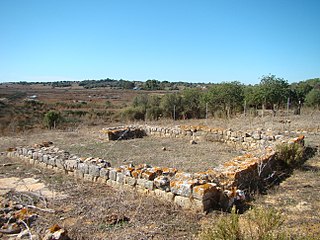
Abicada is the name of Roman ruins in Mexilhoeira Grande, to the north of the civil parish of Alvor, municipality of Portimão, in Algarve region, Portugal. In Roman times it was in the colony of Ipses, in the Roman province of Lusitania, which was authorized to mint currency, and where a woman named Pompeia Exoce looked after the burial of her grandson. Portimão, to east-southeast, known as Portus Magnus at the time, was an important Roman commercial port when the Roman villa was built.
References
- Gigante, M. (1997), "Three Dimensional Mosaic Generation", in M.Gigante,T.L.Kunli (ed.), Insight Through Computer Graphics, World Scientific, ISBN 9789814547321